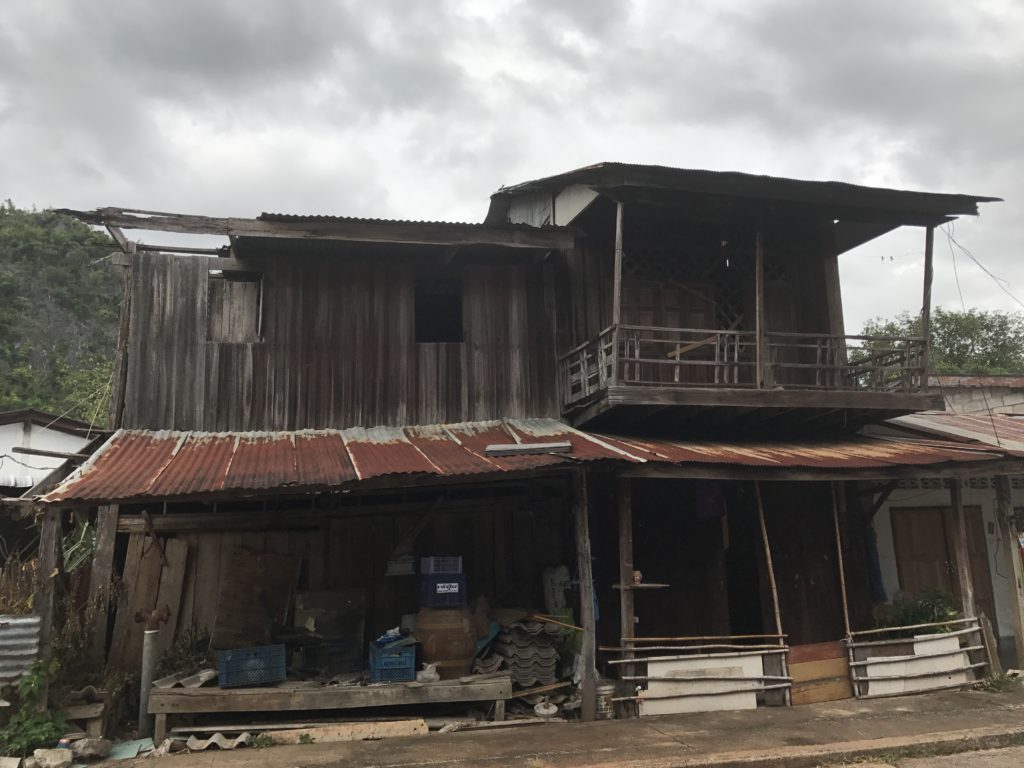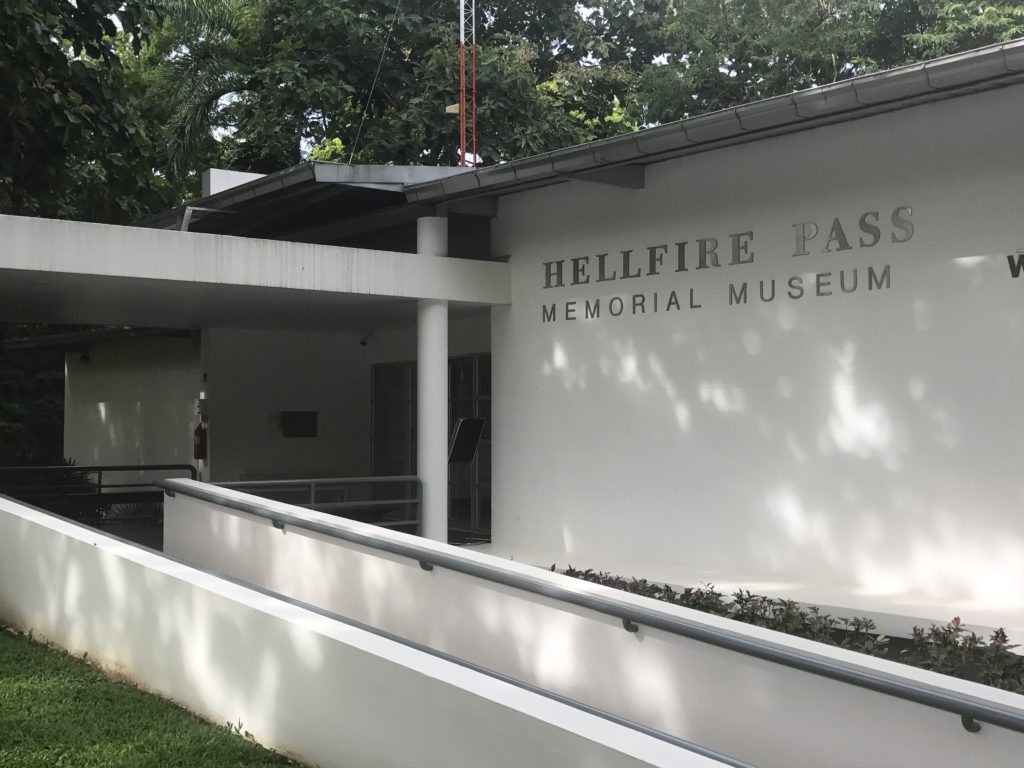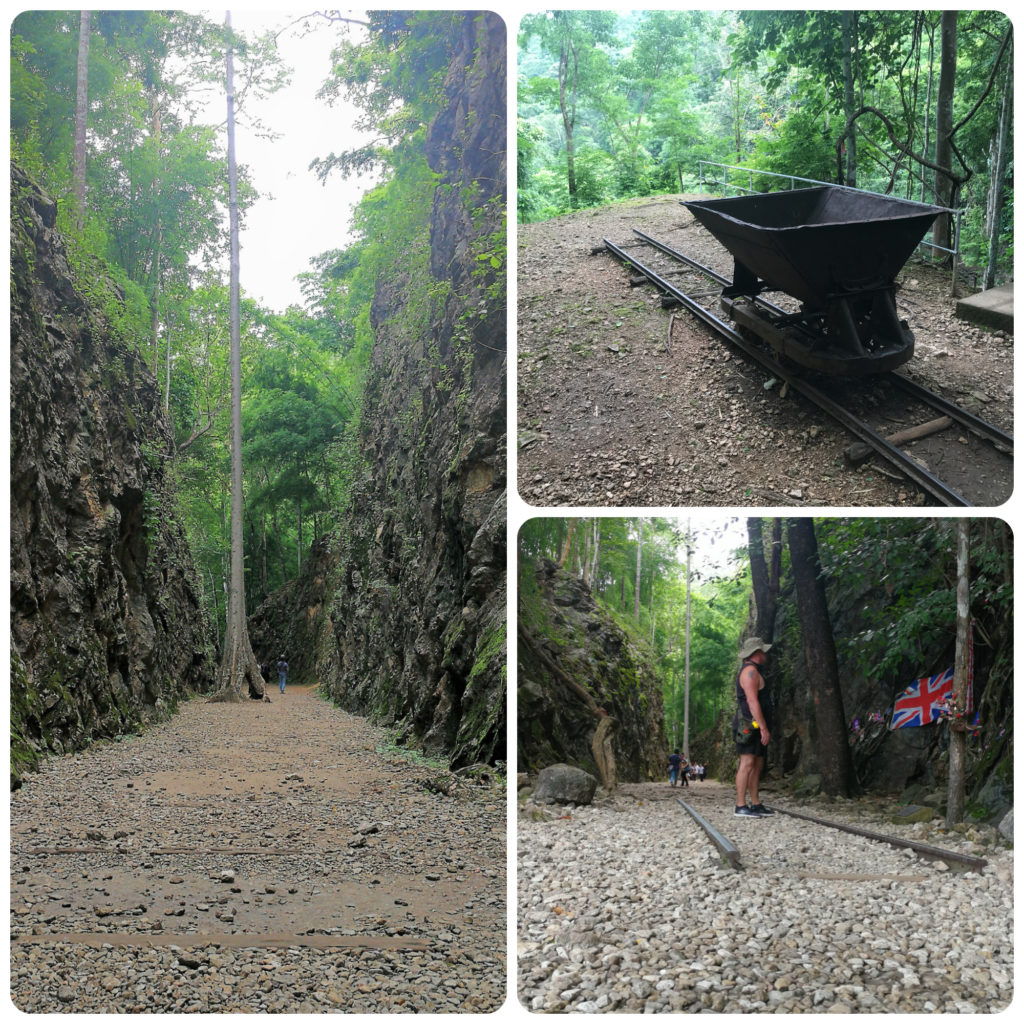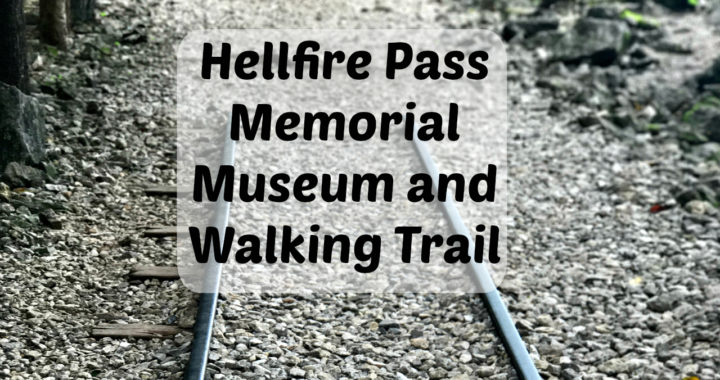Nam Tok
After our 5 hour train trip from Bangkok to Nam Tok, (see previous blog) we soon settled into our amazing Home Stay.
Nam Tok (also known as Sai Yok Noi because of the waterfall in the town) is where the current Death Railway finishes. It is also the closest township to Hell Fire Pass.
There are also numerous National Parks, waterfalls and caves to visit in the surrounding areas (more on those in upcoming blogs).
During the building of the Burma/Thailand Death Railway in WWII, numerous POW camps were positioned along the trail and Nam Tok played an import role as a transit town. Thousands of prisoners passed through the area to continue further up the track as they progressed further towards Burma. Both POW camps and Japanese camps were established here.

Old quarter of Nam Tok
There is an old part and newer part of the town where the road was obviously diverted to bypass the old.
We were within walking distance to both areas and as usual set off on foot to explore. This proved to be a little hazardous due to the amount of stray dogs that roam the streets.
We were pleased that we had taken our umbrellas with us as a couple of times, we had to have them at the ready as we were challenged by a few of the ‘head of the pack’ leaders.
Hellfire Pass
We mounted our trusty scooter and headed out to Hellfire Pass which is approximately 20km from Nam Tok.
Known by the Japanese as Konyu Cutting, the pass is infamous for the extremely harsh conditions and heavy loss of life suffered by its Asian Labourers and POW during its construction.
These men worked 16-18 hour days to complete the 17m high and 110m long cutting through solid limestone and quartz. It got the name Hellfire Pass because of the sight of skeleton type figures labouring by oil fired bamboo torches that created eerie shadows and was said to resemble a scene from Hell.
This section of the Death Railway was particularly difficult to build as it was the largest rock cutting on the railway. It was still very remote and the labourers and POW lacked proper construction tools.
Treatment of the labourers and POW was harsh and in the 12 weeks it took to build just this section of the railway, 69 men were beaten to death and many more were to die of cholera, dysentery, starvation and exhaustion.
Hellfire Pass Memorial Museum and Walking Trail
In the 1980s, a handful of Australian survivors rediscovered the overgrown Hellfire Pass section of the route and campaigned to turn it into a memorial.
The Memorial Museum at Hellfire Pass was built by the Office of Australian War Graves in a joint project between the Australian and Thai Governments.

We arrived at the museum right on opening time at 9am. We knew that this was a popular destination for tour groups travelling from Kanchanaburi or Bangkok. This enabled us to be able to wander around the exhibits with minimal disruption from other patrons.
Upon entry, you are given a portable audio guide and headphones. This is something we would definitely recommend you do. There are corresponding numbers to press as you wander around. This gives you an amazing account of what you are looking at and also commentary from actual surviving POW. This was particularly prevalent when we went on the Walking Trail.
Inside, there are exhibitions telling the stories of the POW’s misery along with personal items like letters, clothes and tools. It covers the history of WWII in Asia beginning with the first attack by Japan in 1941.
Walking Trail
The actual Hellfire Pass (Konyu Cutting) is a 250m walk from the museum. You need to wind your way down some well built wooden stairs and continue along a short distance until you come to the cutting.
If you want to walk the entire trail, you need to register with reception on arrival. We were given a handheld 2 way radio so that we could call up for help if needed.
Armed with our portable audio headset, handheld radio and water, we set off to explore as much of the Death Railway as we could. The walking trail continues for a further 4km along the abandoned railway line.
Upon arrival at the actual Hellfire Pass, we were struck with the massive task that these labourers and POW’s were faced with.

Hellfire Pass (Konyu Cutting)
At the far end of the pass is a memorial built to honour the prisoners who lost their lives building this railway. Anzac Day ceremonies are held here every year and it is said that the attendees of this ceremony can sense a ‘presence’ as the lone piper stands high on the cutting playing The Last Post as the sun rises over the gorgeous valley and forests that surrounds the area.
It was a surprisingly emotional walk as we wandered along and could envisage what went on, thanks to the amazing audio commentary. There was a certain silence that prevailed where we could not even hear any birdsong.

the 4km Walking Trail through tropical jungles
Nearly all of the tour groups only walk as far as Hellfire Pass. As we continued further along the trail, we were on our own. We only encountered a very small number of others coming from the other direction.
It was quite rough underfoot and the tropical humid conditions made the going hot and sticky but the audio commentary provided us with a distraction from any discomfort. It also made you fully appreciate the conditions these workers had to go through. Our slight discomfort paled in comparison to their sufferings.
All along the trail were reminders of the railway. We could see some of the original sleepers carried and laid by hand. Metal spikes pounded into the sleepers to keep the tracks in place. Concrete holes still evident where support poles were placed to hold the trestle bridges steady while taking the weight of engines and carriages.

Reminders everywhere, depicting pain and suffering
The last 1.4km of the trail has been temporarily closed (although it has been for some time) with no view to it reopening any time soon.
We could not find any information as to the reason for it’s closure but we would have liked to continue to view the sites of more camps and bridges.
Death Toll
Forced labour was used in the construction of the 415km Death Railway.
More than 200,000 South East Asian civilian labourers (known as Coolies) and 60,000 POWs worked on the railway construction.
The dead POWs included 6,904 British, 2,802 Australians, 2,782 Dutch and 133 Americans – totalling 12,621. The Japanese did not record the deaths of the SE Asian labourers but it is believed to be in excess of 60,000.
After the end of the war, 111 Japanese military officials were tried for war crimes and 32 of these were sentenced to death and others receiving life prison sentences. No compensation or reparations have been provided to SE Asia victims.
Summary
Our visit to Hellfire Pass will be remembered by us as a sobering and sombre day.
The Memorial Museum and Walking Trail will ensure that these men will not be forgotten.
It has been constructed and run in a very respectful manner and thankfully lacks the tacky commercialism which plagues the Bridge Over the River Kwai.
Most of our research that we did before arriving recommended that the average visiting time would be around 2 hours. We spent close to 4 hours. We were captivated with all the exhibits and soaked up the history surrounding the construction of the Death Railway.

Memorials to those who didn’t make it
It is a fitting memorial to those who suffered, died and survived the atrocities that surrounds the building of this railway. This will ensure that they will not be forgotten.
Click on the link below for our day at Hellfire Pass.
